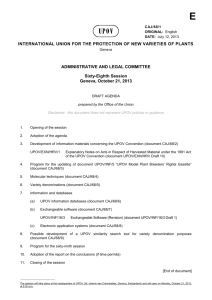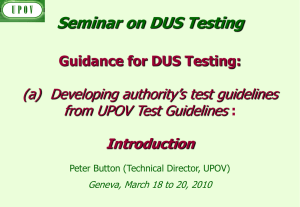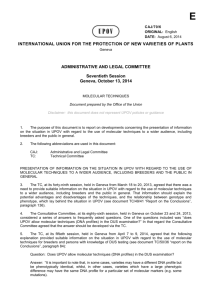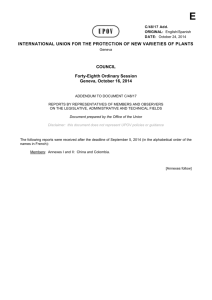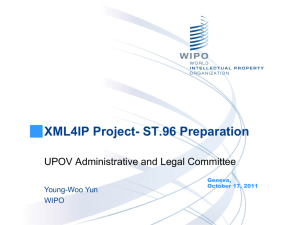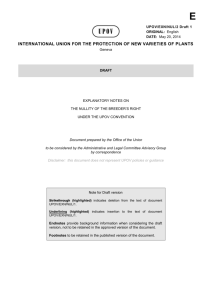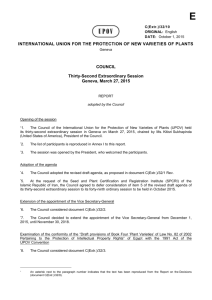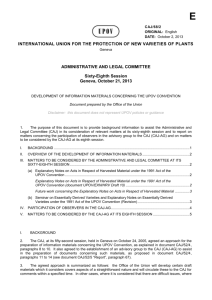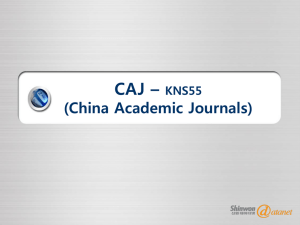Guidance for Members of UPOV on Ongoing Obligations and
advertisement
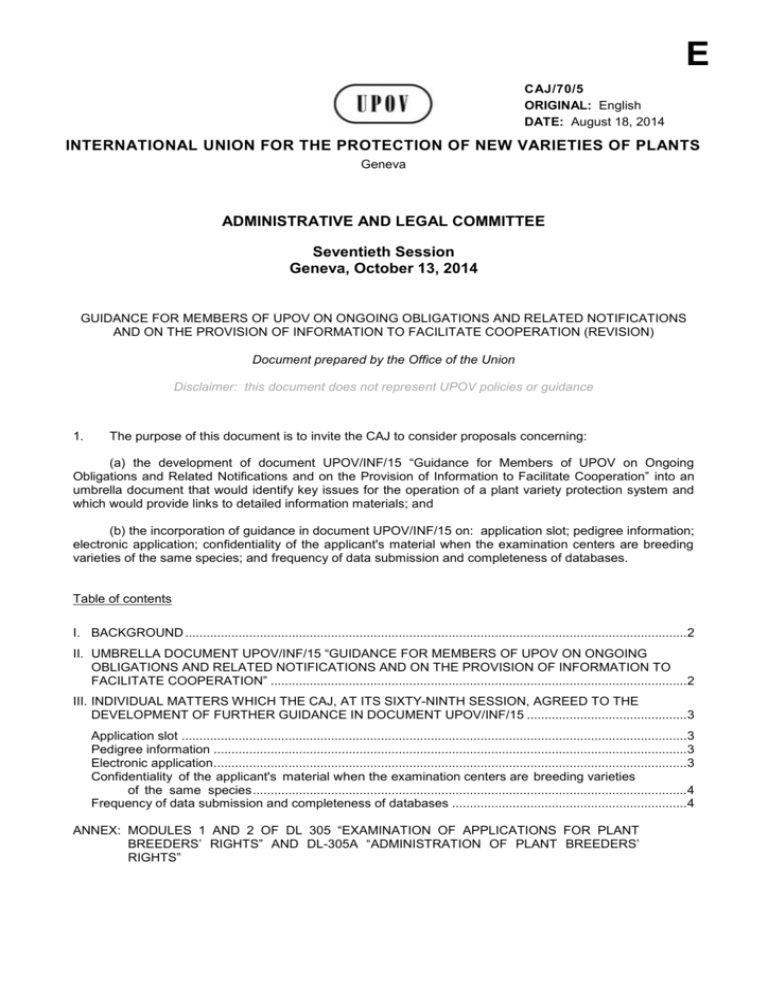
E CAJ/70/5 ORIGINAL: English DATE: August 18, 2014 INTERNATIONAL UNION FOR THE PROTECTION OF NEW VARIETIES OF PLANTS Geneva ADMINISTRATIVE AND LEGAL COMMITTEE Seventieth Session Geneva, October 13, 2014 GUIDANCE FOR MEMBERS OF UPOV ON ONGOING OBLIGATIONS AND RELATED NOTIFICATIONS AND ON THE PROVISION OF INFORMATION TO FACILITATE COOPERATION (REVISION) Document prepared by the Office of the Union Disclaimer: this document does not represent UPOV policies or guidance 1. The purpose of this document is to invite the CAJ to consider proposals concerning: (a) the development of document UPOV/INF/15 “Guidance for Members of UPOV on Ongoing Obligations and Related Notifications and on the Provision of Information to Facilitate Cooperation” into an umbrella document that would identify key issues for the operation of a plant variety protection system and which would provide links to detailed information materials; and (b) the incorporation of guidance in document UPOV/INF/15 on: application slot; pedigree information; electronic application; confidentiality of the applicant's material when the examination centers are breeding varieties of the same species; and frequency of data submission and completeness of databases. Table of contents I. BACKGROUND ............................................................................................................................................. 2 II. UMBRELLA DOCUMENT UPOV/INF/15 “GUIDANCE FOR MEMBERS OF UPOV ON ONGOING OBLIGATIONS AND RELATED NOTIFICATIONS AND ON THE PROVISION OF INFORMATION TO FACILITATE COOPERATION” ..................................................................................................................... 2 III. INDIVIDUAL MATTERS WHICH THE CAJ, AT ITS SIXTY-NINTH SESSION, AGREED TO THE DEVELOPMENT OF FURTHER GUIDANCE IN DOCUMENT UPOV/INF/15 ............................................. 3 Application slot .............................................................................................................................................. 3 Pedigree information ..................................................................................................................................... 3 Electronic application ..................................................................................................................................... 3 Confidentiality of the applicant's material when the examination centers are breeding varieties of the same species .......................................................................................................................... 4 Frequency of data submission and completeness of databases .................................................................. 4 ANNEX: MODULES 1 AND 2 OF DL 305 “EXAMINATION OF APPLICATIONS FOR PLANT BREEDERS’ RIGHTS” AND DL-305A “ADMINISTRATION OF PLANT BREEDERS’ RIGHTS” CAJ/70/5 page 2 I. BACKGROUND 2. The CAJ, at its sixty-ninth session, held in Geneva, on April 10, 2014, considered document CAJ/69/10 “Matters raised by the International Seed Federation (ISF)” and agreed to the development of document UPOV/INF/15 “Guidance for Members of UPOV on Ongoing Obligations and Related Notifications and on the Provision of Information to Facilitate Cooperation” into an umbrella document that would identify key issues for the operation of a plant variety protection system and provide a link to relevant detailed guidance. The CAJ, at its sixty-ninth session, further agreed to amend the title of document UPOV/INF/15 accordingly and to incorporate relevant elements from Module 1 “Plant Breeders’ Rights Office” and Module 2 “Administration of applications” of the UPOV Distance Learning Program “Examination of applications for plant breeders’ rights” (DL 305) and the elements agreed by the CAJ in relation to the matters presented in document CAJ/69/10 “Matters raised by the International Seed Federation (ISF)” (see documents CAJ/69/12 “Report on the Conclusions”, paragraph 92, and CAJ/69/10, paragraph 32). The CAJ agreed, at its sixty-ninth session, in relation to the next steps, that the Office of the Union would prepare relevant documents on the issues concerning each of the items that the CAJ had agreed to develop further guidance and would present those issues for further consideration by the CAJ at its seventieth session. At that point, the CAJ would decide on the relevant bodies that might consider those issues (see document CAJ/69/12 “Report on the Conclusions”, paragraph 93). II. UMBRELLA DOCUMENT UPOV/INF/15 “GUIDANCE FOR MEMBERS OF UPOV ON ONGOING OBLIGATIONS AND RELATED NOTIFICATIONS AND ON THE PROVISION OF INFORMATION TO FACILITATE COOPERATION” 3. Document UPOV/INF/15 currently provides guidance for members of the Union on ongoing obligations and related notifications, and on the provision of information to facilitate cooperation. Upon their appointment, representatives to the Council are provided with a copy of document UPOV/INF/15. 4. The invitation of the Consultative Committee, at its eighty-sixth session, at its eighty-sixth session, held in Geneva on October 23 and 24, 2013, was to develop document UPOV/INF/15 into an umbrella document that would provide: (i) an overview of the operation of key issues for a plant variety protection system; and (ii) a link to relevant detailed guidance. (see document C/47/15 Rev. “Report by the President on the work of the eighty-sixth session of the Consultative Committee; adoption of recommendations, if any, prepared by that Committee”, paragraphs 62 to 66). 5. The CAJ, at its sixty-ninth session, held in Geneva, on April 10, 2014, considered document CAJ/69/10 “Matters raised by the International Seed Federation (ISF)” and agreed to the development of document UPOV/INF/15 “Guidance for Members of UPOV on Ongoing Obligations and Related Notifications and on the Provision of Information to Facilitate Cooperation” into an umbrella document that would identify key issues for the operation of a plant variety protection system and provide a link to relevant detailed guidance. 6. The CAJ, at its sixty-ninth session, further agreed to amend the title of document UPOV/INF/15 accordingly and to incorporate relevant elements from Module 1 “Plant Breeders’ Rights Office” and Module 2 “Administration of applications” of the UPOV Distance Learning Program “Examination of applications for plant breeders’ rights” (DL-305) and the elements agreed by the CAJ in relation to the matters presented in document CAJ/69/10 (see documents CAJ/69/12 “Report on the Conclusions”, paragraph 92, and CAJ/69/10, paragraph 32 and Section III of this document “Individual matters which the CAJ, at its sixty-ninth session, agreed to the development of further guidance in document UPOV/INF/15”). The Consultative Committee agreed to the splitting of DL-305 into two separate courses (DL-305A and DL305B). Modules 1 and 2 are contained in DL-305A “Administration of plant breeders’ rights”. CAJ/70/5 page 3 7. On the above basis, document UPOV/INF/15/3 Draft 1 has been prepared with the following proposals for consideration by the CAJ at its seventieth session: (a) change of the title from “Guidance for members of UPOV on ongoing obligations and related notifications and on the provision of information to facilitate cooperation” to “Guidance for members of UPOV”; (b) changes in the Preamble to clarify the purpose of developing document UPOV/INF/15 into an umbrella that would provide: (i) an overview of the operation of key issues for a plant variety protection system; and (ii) a link to relevant detailed guidance; and (c) inclusion of relevant elements from Module 1 “Plant Breeders’ Rights Office” and Module 2 “Administration of applications” of DL-305 “Examination of applications for plant breeders’ rights” and DL-305A “Administration of plant breeders’ rights” (Modules 1 and 2 of DL-305 and DL-305A are reproduced in the Annex to this document). III. INDIVIDUAL MATTERS WHICH THE CAJ, AT ITS SIXTY-NINTH SESSION, AGREED TO THE DEVELOPMENT OF FURTHER GUIDANCE IN DOCUMENT UPOV/INF/15 8. The CAJ, at its sixty-ninth session, agreed to incorporate in document UPOV/INF/15 relevant elements agreed by the CAJ in relation to the matters presented in document CAJ/69/10 “Matters raised by the International Seed Federation (ISF)” (see documents CAJ/69/10, paragraph 32 and CAJ/69/12 “Report on the Conclusions”, paragraphs 80, 81, 83, 88, 90 and 92). 9. On that basis, proposals on the following matters are presented in document UPOV/INF/15/3 Draft 1, as indicated. Application slot 10. The CAJ, at its sixty-ninth session, endorsed the development of guidance on the time period for the filing of applications in document UPOV/INF/15 (see document CAJ/69/12 “Report on the Conclusions”, paragraph 80). 11. Proposed guidance is presented in document UPOV/INF/15/3 Draft 1, as highlighted text in paragraph 45. Pedigree information 12. The CAJ, at its sixty-ninth session, agreed to the development of further guidance on requests for pedigree information (see document CAJ/69/12 “Report on the Conclusions”, paragraph 81). 13. Proposed guidance is presented in document UPOV/INF/15/3 Draft 1, as highlighted text in paragraphs 36 and 64. Electronic application 14. The CAJ, at its sixty-ninth session, noted the existing initiatives, as set out in document CAJ/69/10, paragraph 9, concerning electronic applications (see document CAJ/69/12 “Report on the Conclusions”, paragraph 82). The latest developments concerning the UPOV prototype electronic form are presented in document CAJ/70/7 “Electronic application systems”. 15. The CAJ, at its sixty-ninth session, agreed to the development of guidance in document UPOV/INF/15 on the possibility to file applications electronically (see document CAJ/69/12 “Report on the Conclusions”, paragraph 83). CAJ/70/5 page 4 16. Proposed guidance concerning the possibility to file applications electronically is presented in document UPOV/INF/15/3 Draft 1, paragraph 46. Confidentiality of the applicant's material when the examination centers are breeding varieties of the same species 17. The CAJ, at its sixty-ninth session, noted the discussions that had taken place in the CAJ concerning the “Recommendations to Ensure the Independence of those DUS Examination Centers Which Have, or Have Links to, Breeding Activities”, as set out in document CAJ/69/10, paragraph 22 (see document CAJ/69/12 “Report on the Conclusions”, paragraph 87). 18. The CAJ, at its sixty-ninth session, agreed to the development of guidance in document UPOV/INF/15 on confidentiality of applicants’ material when DUS examination centers have, or have links to, breeding activities (see document CAJ/69/12 “Report on the Conclusions”, paragraph 88). 19. Proposed guidance is presented in document UPOV/INF/15/3 Draft 1, as highlighted text in paragraph 62. Frequency of data submission and completeness of databases 20. The CAJ, at its sixty-ninth session, noted that document CAJ/69/6 “UPOV information databases” contained relevant matters on the regular provision of information to the PLUTO Plant Variety Database and that document CAJ/69/6 contained the replies from a survey of members of the Union on their use of databases for plant variety protection purposes and on their use of electronic application systems (see document CAJ/69/12 “Report on the Conclusions”, paragraph 89). 21. The CAJ, at its sixty-ninth session, agreed to the development of guidance concerning frequency of data submission and completeness of databases in conjunction with the updating of document UPOV/INF/5 “UPOV Model Plant Breeders’ Rights Gazette”, as set out in document CAJ/69/10, paragraph 26, and in document UPOV/INF/15 (see document CAJ/69/12 “Report on the Conclusions”, paragraph 90). 22. The latest developments concerning the updating of document UPOV/INF/5 are presented in document CAJ/70/3 “Revision of document UPOV/INF/5 ‘UPOV Model Plant Breeders’ Rights Gazette’”. 23. The CAJ may wish to note that the amended Section 4 “Frequency of data submission” of the Program of the UPOV Plant Variety Database (PLUTO), which was agreed by the CAJ, at its sixty-eighth session, held in Geneva on October 21, 2013, is the basis for the proposed guidance in document UPOV/INF/15/3 Draft 1, paragraph 25 (see document CAJ/68/11“Report”, paragraph 27). 24. Proposed guidance on frequency of data submission and completeness of databases is presented in document UPOV/INF/15/3 Draft 1, as highlighted text in paragraphs 25 and 46. 25. The CAJ is invited to consider document UPOV/INF/15/3 Draft 1. [Annex follows] CAJ/70/5 ANNEX MODULES 1 AND 2 OF DL 305 “EXAMINATION OF APPLICATIONS FOR PLANT BREEDERS’ RIGHTS” AND DL-305A “ADMINISTRATION OF PLANT BREEDERS’ RIGHTS” MODULE 1: THE PLANT BREEDERS’ RIGHTS OFFICE Objective The objective of this Module is to provide an overview of the structure and functions of a Plant Breeders’ Rights Office (PBR Office). CAJ/70/5 Annex, page 2 INTRODUCTION Applications for plant breeders’ rights (PBR) are subject to examination by the authority in the territory of the UPOV member concerned. According to Article 30 of the 1991 Act and Article 7 of the 1978 Act of the UPOV Convention, UPOV members shall maintain an authority entrusted with the task of granting PBR, also referred to as the “PBR Office” in this course. UPOV members should also ensure that the public is informed about applications and grants of breeders' rights, as well as proposed and approved denominations. “Article 30 Implementation of the Convention (1) Each Contracting Party shall adopt all measures necessary for the implementation of this Convention; in particular, it shall: […] (ii) maintain an authority entrusted with the task of granting breeders' rights or entrust the said task to an authority maintained by another Contracting Party; (iii) ensure that the public is informed through the regular publication of information concerning applications for and grants of breeders' rights, and proposed and approved denominations.” The PBR Office will vary in size and structure according to how each UPOV member provides for the implementation of the UPOV Convention and the examination of applications for PBR, in particular. The examination of applications for PBR is required in Article 12 of the 1991 Act and in Article 7 of the 1978 Act of the UPOV Convention. Any decision to grant a breeder's right shall require an examination for compliance with the conditions for protection, as set out in Articles 5 to 9 of the 1991 Act and Article 6 of the 1978 Act of the UPOV Convention, namely the requirements of Novelty, Distinctness, Uniformity and Stability (DUS), a suitable denomination and the applicable formalities. “Article 12 Examination of the Application Any decision to grant a breeder's right shall require an examination for compliance with the conditions under Article 5 to Article 9. In the course of the examination, the authority may grow the variety or carry out other necessary tests, cause the growing of the variety or the carrying out of other necessary tests, or take into account the results of growing tests or other trials which have already been carried out. For the purposes of examination, the authority may require the breeder to furnish all the necessary information, documents or material.” PBR Offices need to take appropriate steps to safeguard the legitimate interests of the breeder with regard to documents, information and material provided as part of the application. UPOV has developed the “UPOV Collection” of guidance and information materials concerning plant variety protection under the UPOV Convention. However, it should be recalled that the only binding obligations on members of the Union are those contained in the text of the UPOV Convention itself, and the materials must not be interpreted in a way that is inconsistent with the relevant Act for the member of the Union concerned. A current list of the contents and status of materials in the UPOV Collection is provided in the Table of Contents published on the UPOV website and illustrated below 1. Members of the Union (two sets per member of the Union) and observer States and organizations (one set per State/organization) are provided with a set of binders to contain the “UPOV Collection”. In the first instance, printed versions of all the documents in the “UPOV Collection”, except for Test Guidelines, are provided with the folders. After the initial supply of the set of “UPOV Collection” folders with a printed set of documents, no further printed documents are provided by the Office of the Union. All designated persons in UPOV bodies receive an electronic notification each time the UPOV Collection is updated. For persons provided with a set of folders, that notification is the trigger for them to print the new versions and replace any previous versions of the documents concerned. Other users can register to receive an electronic notification each time the UPOV Collection is updated. 1 Please note that this table is provided for illustrative purposes and may be out of date at the time of reading: the link to the current table of contents is provided in the text above. CAJ/70/5 Annex, page 3 Table of Contents (a) UPOV Convention (b) UPOV/INF document series (c) Explanatory notes on the UPOV Convention (d) General Introduction to the Examination of Distinctness, Uniformity and Stability and the Development of Harmonized Descriptions of New Varieties of Plants (e) TGP documents (f) Test Guidelines (g) UPOV Collection of Laws and Treaties (UPOV Lex) (h) List of UPOV members (i) Directory of Plant Variety Protection Offices (j) UPOV Organigram (k) Databases and information (l) List of the Taxa Protected by the Members of the Union Cooperation in Examination List of genera and species for which authorities have practical experience in the examination of distinctness, uniformity and stability Plant Variety Database (m) Genie Database References to the materials in the UPOV Collection will be made throughout the DL-305 course for those students wishing to obtain further information on relevant topics. ESTABLISHMENT OF A PBR OFFICE The PBR Office is often established under the ministry responsible for agriculture or the ministry responsible for intellectual property. Ministries responsible for agriculture typically have experience in plant variety related schemes, such as seed certification and the national listing of varieties. However, the PBR Office can, for example, be established under a ministry that is responsible for intellectual property. A UPOV member may also choose to entrust the task of granting breeders’ rights to a PBR Office maintained by another UPOV member, such as a regional or a supranational intergovernmental organization. FUNCTIONS AND STRUCTURE OF A PBR OFFICE The UPOV Convention establishes the activities to be undertaken by the PBR Office, but does not define a particular model. Therefore, UPOV members may organize the PBR Office according to their own situation. The following flow diagram illustrates the basic flow of tasks within a typical PBR Office. Module 2: “Administration of Applications” provides further information on the tasks included in the flow diagram. CAJ/70/5 Annex, page 4 Flow diagram 12: Basic tasks within the PBR Office 2 The notes in the above diagram relate to the administration of examination and are explained in Module 2 “Administration of Applications”. CAJ/70/5 Annex, page 5 MODULE 2: ADMINISTRATION OF APPLICATIONS Objective The objective of this Module is to provide an explanation of the basic tasks of the PBR Office in the administration of applications for plant breeders’ rights. The module provides explanation on the basic tasks within the PBR Office, as presented in the flow diagram in Module I “The Plant Breeders’ Rights Office”. CAJ/70/5 Annex, page 6 APPLICATION FOR PLANT BREEDERS’ RIGHTS (SEE NOTE (A) IN THE FLOW DIAGRAM IN MODULE 1) Introduction Prior to receiving applications for plant breeders’ rights, the PBR Office needs to develop relevant forms and be ready to assign a filing date and time. Legal provisions in some UPOV members allow for the filing of applications in paper copy only. Others allow the use of electronic application forms to substitute or to complement paper copy applications, thereby facilitating the use of databases and information management. In order to accept applications in electronic format, UPOV members may need to have auxiliary systems in place, such as for the recognition of digital signatures, electronic payment and security matters. Applications for protection need to be managed by the PBR Office and their administration may involve the use of specific software applications. The sharing of software applications by UPOV members provides an important means of support for the administration of applications and examination of varieties. Information on the sharing of software by UPOV members is provided in document UPOV/INF/16 “Exchangeable Software” (available at http://www.upov.int/information_documents/en/) Development of forms In order to facilitate the implementation of procedures for filing applications for plant variety protection UPOV has developed model forms that can be used by individual PBR Offices within their national or regional contexts. UPOV Model Application Form Document TGP/5 “Experience and Cooperation in DUS Testing” contains the “UPOV Model Form for the Application for Plant Breeders’ Rights” (TGP/5, Section 2). The UPOV Model Form has the layout shown in the extract on the following page (available at: http://www.upov.int/tgp/en/). When converting the UPOV Model Form into the form of a PBR Office and when drafting explanations for completing that form, the contents and the terminology of the applicable law of the UPOV member need to be taken into account. To ensure that the UPOV Model Form fulfills its function, it is important that the general structure, the contents and the numbering of the individual parts be maintained in the PBR Office’s own forms. A standard UPOV reference has been provided for each field in the UPOV Model Form. For example, for item 1.(a) “Applicant(s) Name(s)”, the standard UPOV reference is “UPOV A1: 1(a)(i)”. To facilitate harmonization and to assist applicants, a PBR Office may include that standard UPOV reference in the corresponding field of the PBR Office’s own form. It is a matter for each PBR Office to decide if the field in the PBR Office’s own form corresponds sufficiently precisely to the field in the UPOV Model Application Form for the standard UPOV reference to be included. Document TGP/5, Section 2 provides further information on the individual items of the UPOV Model Form. CAJ/70/5 Annex, page 7 Technical Questionnaire To help in the process of examining varieties, certain information is requested from the breeder, usually through a Technical Questionnaire to be submitted with the application. The Technical Questionnaire seeks information on specific characteristics of importance for distinguishing varieties, information on the breeding scheme of the variety and any other information which may help to distinguish the variety. It also requests the breeder to identify similar varieties and characteristics by which the candidate may be distinguished from these similar varieties. Where UPOV has developed “Guidelines for the Conduct of Tests for Distinctness, Uniformity and Stability,” or “Test Guidelines”, for individual species or other variety groupings (see http://www.upov.int/test_guidelines/en/), the Test Guidelines provide a model Technical Questionnaire in Chapter 10. Sample of the Variety Document TGP/5 “Experience and Cooperation in DUS Testing”, Section 4 “UPOV Model Form for the Designation of the Sample of the Variety” provides a model to be used in conjunction with the plant material submitted for the examination of candidate varieties. CAJ/70/5 Annex, page 8 Assigning filing date Applications received by the PBR Office need to be assigned a date of filing. This step is relevant for the examination of novelty (see Module 4 “Examining Novelty”) and distinctness (see Module 9 “Examining Distinctness”). The UPOV Convention provides for a right of priority of 12 months, based upon an earlier application for the protection of the same variety with another UPOV member, whereby a subsequent application is treated as if it were filed on the filing date of the first application. The right of priority has effects for the examination of the novelty and distinctness conditions and proposed denominations (see online distance learning course DL-205 “Plant Breeders’ Rights under the UPOV Convention”, Module 4: “Applying for a Plant Breeder’s Right”, and document UPOV/EXN/PRI “Explanatory notes on the right of priority under the UPOV Convention” available at: http://www.upov.int/explanatory_notes/en/). APPLICATION DULY FILED (SEE NOTE (B) IN THE FLOW DIAGRAM IN MODULE 1) Applications need to be checked for compliance with the applicable formalities and fee requirements in order to be considered as a duly filed application. In order for an application to be duly filed it must be submitted by a person that is entitled to a breeder’s right (see Module 3 “Entitlement to a breeder’s right”). Duly filed applications need to be prepared for publication by the case officer or person in charge of the initial processing of the application forms. Information should also be provided for other concerned officers within the PBR Office to prepare for the subsequent steps of the examination. PUBLICATION (SEE NOTE (C) IN THE FLOW DIAGRAM IN MODULE 1) See Module 4 “Information to be published”. EXAMINATION OF REQUIREMENTS (SEE NOTE (D) IN THE FLOW DIAGRAM IN MODULE 1) The examination of novelty, proposed denomination and DUS should be conducted in parallel in order to avoid a delay in the grant of the breeders’ rights. In particular, the UPOV Convention requires that the denomination shall be registered by the PBR Office at the same time as the breeder's right is granted (Article 20(3) of the 1991 Act and Article 13(3) of the 1978 Act). There are different options for administration of the examination. For example, one person may be designated to act as a “case officer” responsible for the administration of all the aspects of the above mentioned examination, or there may be specialized professionals for individual parts of the work. The examination of the denomination will be discussed in Module 6 “Examining the variety denomination”. The examination of novelty will be dealt with in Module 5 “Examining novelty”, while Modules 7 to 13 explain “DUS Examination”. DUS EXAMINATION (SEE NOTE (E) IN THE FLOW DIAGRAM IN MODULE 1) The size and structure of PBR Offices is influenced by the arrangements for DUS testing. A PBR Office may, for example, use one or more of the following arrangements: - The PBR Office conducts growing trials, or other tests, itself (testing by PBR Office) - The PBR Office arranges for another party / other parties to conduct the growing trials or other tests (outside PBR Office). In such an arrangement, another party could include, for example, another PBR Office, an independent institute or the breeder. - The PBR Office takes into account the results of growing tests or other trials which have already been carried out (outside PBR Office). The different options for cooperation between PBR Offices and cooperation with breeders in DUS examination will be further discussed in Module 13 “Cooperation in DUS examination”. Document TGP5 “Experience and Cooperation in DUS Testing”, Section 1 “Experience and Cooperation in DUS Testing” also CAJ/70/5 Annex, page 9 provides useful information with a model administrative agreement for international cooperation in the testing of varieties. UPOV members may have informal arrangements for the purchasing of DUS test reports (for instance exchange of letters). PROPOSED DECISION (SEE NOTE (F) IN THE FLOW DIAGRAM IN MODULE 1) On the basis of the results of novelty, denomination and DUS examination a decision can be proposed with regard to the grant of protection. Such a decision may be proposed to the authority responsible for the grant of the breeders’ rights (PBR Office) by an official or by a group of professionals, such as a board or a panel of experts. If the decision is negative, the rejection of the application shall be published (see Module 4 “Information to be published”). The applicant may make an appeal against a proposed negative decision by the PBR Office. OBJECTIONS (SEE NOTE (G) IN THE FLOW DIAGRAM IN MODULE 1) The PBR Office needs to have procedures in place to handle objections received as a result of the publication of information. Objections received from the public may bring relevant data for the examination of applications and denominations. The applicant may also provide further relevant information when appealing against a decision of the PBR Office. TITLE GRANT (SEE NOTE (H) IN THE FLOW DIAGRAM IN MODULE 1) If the decision with regard to the grant of protection if positive, the title shall be granted. The title shall be transmitted to the holder of the breeder’s right. Grants of breeders’ rights and approved denominations shall be registered and published at the same time by the PBR Office (see Module 4 “Information to be published”). MATTERS AFTER THE GRANT (SEE NOTE (I) IN THE FLOW DIAGRAM IN MODULE 1) The tasks of the PBR Office after the grant of the PBR include the obligation to maintain up-to-date relevant information in the registry and databases, the management of the payment of fees (if applicable) by the breeder to keep the PBR in force, and the publication of relevant information after the grant, for example, the termination of the PBR and changes concerning the holder of the PBR and denominations (see Module 4 “Information to be published”). The PBR Office may also choose to take measures to verify the maintenance of the variety. [End of Annex and of document]
